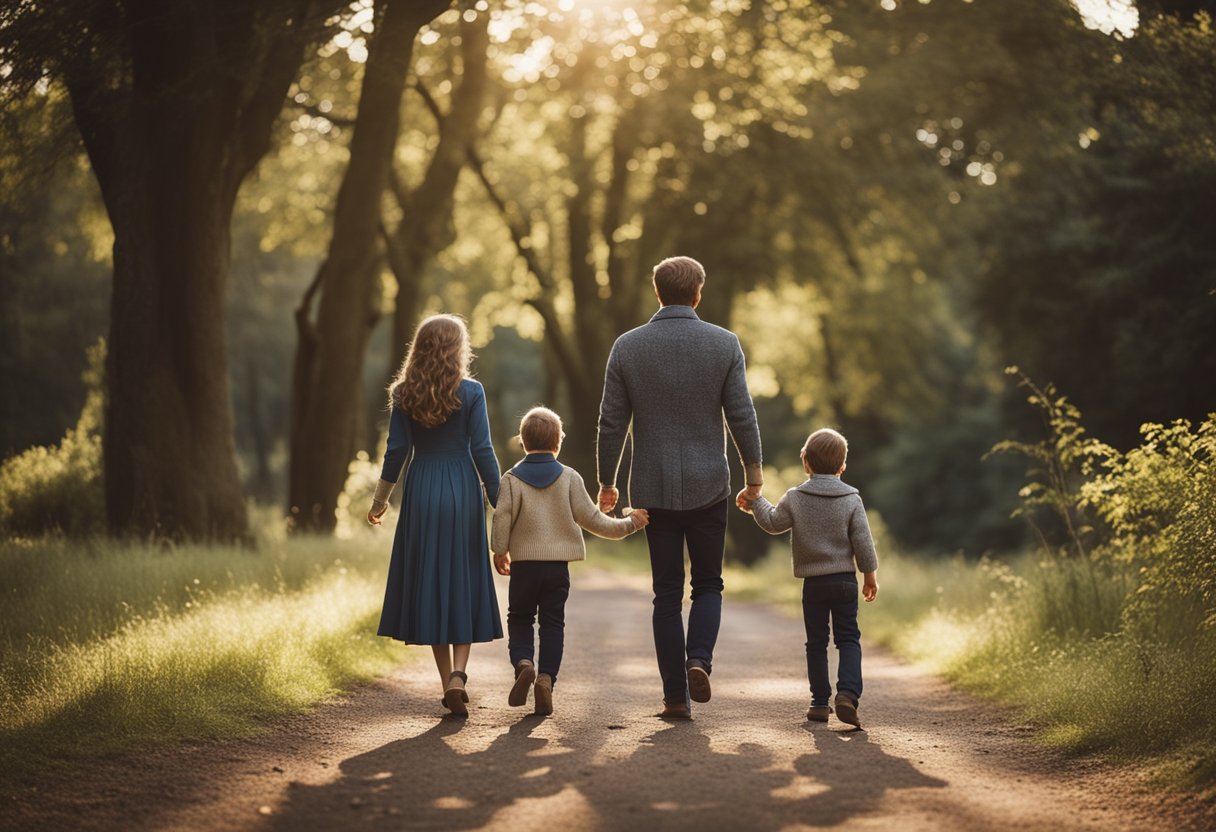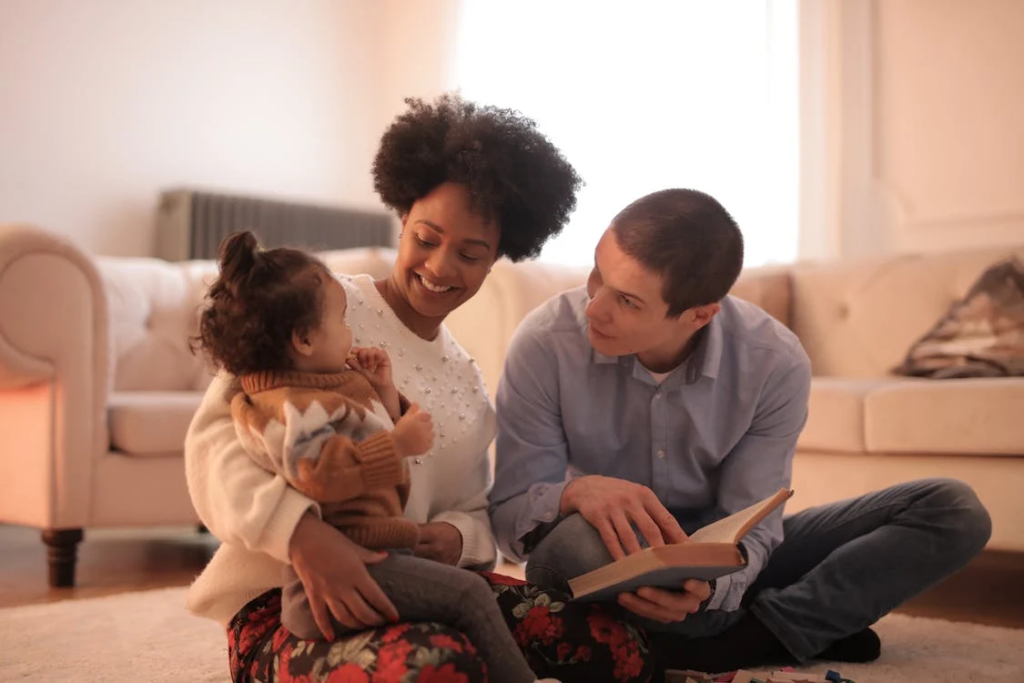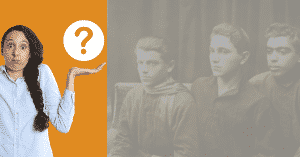Understanding the importance of family stories goes beyond just knowing where we come from – it provides us with deeper insight into our families’ values and unique experiences. Our ancestors’ lives can serve as a treasure trove of knowledge, inspiration, and life lessons. Additionally, research shows that sharing family history can positively impact children’s emotional well-being and contribute to their sense of belonging.
When it comes to techniques for sharing family stories, there are plenty to choose from. Creativity is key, whether we decide to embrace technology by utilizing interactive digital mediums, or engage children in family history activities that foster curiosity and critical thinking. Ultimately, our goal is to ensure that these stories do not remain mere fragments of the past, but instead become a living connection to our roots and shared identity.
Key Takeaways
- Sharing family stories helps children develop a sense of identity and connection to their ancestors.
- Emphasizing the importance of family history can foster emotional well-being and teach valuable life lessons.
- Creative techniques and activities can make family storytelling more engaging and enjoyable for children.
Understanding the Importance of Family Stories
As a parent or caretaker, I know the value that family stories hold in shaping a child’s identity and self-esteem. These stories help form a strong family narrative, allowing kids to develop a sense of connection to their background and a greater understanding of their own place within the family unit. By sharing family stories, I find that children become more confident and resilient individuals, building a robust foundation for their emotional well-being.
Incorporating storytelling into our daily interactions, I make it a point to recount both shared experiences and tales of family history. Children benefit from listening to and engaging with these stories, as it helps them feel grounded in their family’s past while also giving them context for their present lives. Psychology Today highlights the importance of intergenerational stories in fostering positive youth development.
Three core areas I focus on when sharing family stories with children are:
- Building self-esteem: Recounting various family experiences garners a rich understanding of one’s roots, making kids feel secure in their place within the family structure. Family Search notes that adolescents who can recall specific details of family narratives have higher self-esteem and resilience;
- Creating a sense of belonging: Family stories help establish a unique, shared identity, giving children a sense of collectively being part of a unified, loving unit;
- Fostering emotional well-being: Using storytelling to discuss both positive and negative experiences can serve as a framework for understanding and processing emotions, promoting mental health and resilience in the face of life’s challenges.
As a narrator, I prioritize maintaining a confident, knowledgeable, and neutral tone while sharing these stories. This approach keeps the focus on the relevance and significance of the tales, without introducing personal biases or exaggerated claims.
In conclusion, sharing family stories with children is more than just a means of entertainment or conversation – it’s a vital tool for developing their identity and emotional resilience. As someone who values the importance of family narratives, I strive to continue fostering this connection with kids through the art of storytelling.
Techniques For Sharing Family Stories with Children
As someone who enjoys sharing family history, I have found that making it engaging for children can be both fun and rewarding. Here are some techniques I have discovered that can help bring ancestors to life for young audiences.
First, focusing on storytelling instead of simply recounting facts and figures can keep children engaged. Rather than listing names, dates, and places, tell a captivating story about a family member or ancestor. For example, I often narrate the adventures of my grandparents when they first moved to a new country, describing their emotions, challenges, and triumphs.
Another strategy is to incorporate visual aids, like photographs, maps, or heirlooms, to help children visualize the stories you are sharing. I have found that showing a picture of my great-grandmother’s handwritten recipe book easily sparks my children’s curiosity about her life and culinary talents.
Encouraging children to participate in the storytelling process can also be beneficial. I like to ask open-ended questions during the story, prompting kids to imagine themselves in their ancestors’ shoes or to predict what might happen next. This interactive approach keeps them engaged, and it helps them develop empathy and understanding for their family members’ experiences.
Finally, using modern technology, such as recording audio stories or creating digital family trees, can capture children’s interest.
By employing these techniques, I have been able to share family stories with my children in an engaging and meaningful way, instilling a sense of pride and connection to their heritage. And remember, the most important aspect of sharing family history is creating enjoyable bonding moments with the kids while passing down valuable knowledge about their roots.
Bringing Ancestors to Life
As I delve into family history and genealogy, it is essential for me to share those findings with the younger generations, ensuring that they appreciate their ancestors and can continue to pass on their remarkable heritage. Learning the stories of our predecessors allows us to better understand our family’s history and appreciate our own roles within it.
I like to begin by gathering essential information from standard genealogical records, such as birth and marriage records. This provides a strong foundation upon which to build vivid, engaging narratives. In addition to textual documents, photographs and keepsakes play a crucial role in connecting our families with their ancestors. These visual elements help children understand the transformations that occurred over time, the lifestyles our ancestors lived, and the sacrifices they made.
To engage and inspire children, I emphasize storytelling as the primary method of sharing our family history. As I recount our ancestors’ experiences, the children gain deeper insight into their personal backgrounds and values. In my stories, I focus on the human aspects, highlighting not only the accomplishments but also the trials and hardships our ancestors endured, instilling a sense of resilience and pride.
When presenting this information to children, I find that using creative and interactive methods like family history games keep them engaged and help them retain the information better. This could include quizzes, puzzles, and matching games, all centered around our ancestors’ lives and achievements.
Lastly, I believe that celebrating family history with food is an innovative way to introduce children to their ancestors’ cultures. Preparing traditional dishes and sharing meals together creates a tactile and immersive experience that helps them connect to their roots on a deeper level.
By combining these techniques, I’m confident in my ability to bring our ancestors to life and ensure that the rich history of our family is preserved and cherished by younger generations.
Building Connection Through Family History

As I delve into the world of family history, I’ve discovered the immense value in sharing these stories with children and adolescents. It not only builds a stronger sense of connection and belonging but also helps them understand their roots and the lives of their ancestors.
One key aspect of building connection through family history is creating a family tree, where children can easily visualize their extended family and the relationships within it. By working together on this project, we not only engage the younger generation but also enhance their feeling of being part of a larger, interwoven family unit. It’s essential for children to be aware of the various branches of their family to truly appreciate their diverse heritage.
When I explore family stories with my own children, I find it beneficial to focus on narratives that emphasize the shared values and traditions passed down through generations. This approach gives them a deeper understanding of their family’s identity and creates a sense of belonging. For instance, recounting tales of cultural celebrations, family gatherings, or heirloom recipe preparations can spark curiosity and inspire conversations about their ancestors’ lives.
Another aspect that helps bring ancestors to life is by integrating their experiences into the historical context of the era in which they lived. For example, explaining how family members coped during the Great Depression, or their active involvement during different wars, can give children a more profound appreciation for the hardships faced and the strength demonstrated by their ancestors. By providing this broader perspective, we further enrich their understanding of their family’s resilience and history.
Moreover, incorporating various multimedia elements, such as photographs or historical documents, can greatly enhance the storytelling experience. Children tend to connect better with visual aids, and these can create a vivid and lasting impression of their heritage.
Ultimately, by sharing family stories, we forge a strong connection between children, adolescents, and their ancestral past, reinforcing their sense of belonging within their extended family. This also cultivates a sense of pride in the family’s roots, strengthening the bonds across generations.
The Use of Personal and Ancestral Stories in Child Development
From my personal experience, incorporating family stories into a child’s upbringing can significantly impact their development. As I’ve shared personal and ancestral stories with children, I’ve witnessed the positive effects it has on fostering their self-confidence, appreciation of their heritage, and overall emotional well-being.
In particular, I’ve noticed that retelling stories about personal challenges and how our ancestors overcame obstacles not only builds their self-confidence, but also offers valuable life lessons. It helps children understand that hardships are a natural part of life and that they, too, can overcome them as their ancestors did before them. I often remind children that, just like their grandparents, they possess the strength to accomplish great things.
When I discuss family history with children, I also emphasize the importance of understanding and appreciating their cultural background. This has led to a greater sense of belonging and encourages them to remain connected to their family customs and traditions. By sharing stories of the past, I help them realize the wealth of knowledge, experiences, and wisdom they can draw from their ancestral roots.
One technique that has proven effective in engaging children with family stories is the use of visual materials, such as photographs, heirlooms, or family trees. By including these, I’ve observed a genuine curiosity and excitement emerge as they learn about their family history. Through these concrete connections, they can see that their ancestors were real people who faced challenges, celebrated triumphs, and sometimes made mistakes, just like them.
In conclusion, incorporating personal and ancestral stories into a child’s life can greatly influence their development by building self-confidence, fostering an appreciation of their heritage, and creating a stronger sense of identity. By sharing these valuable stories, I am playing a vital role in shaping their emotional well-being and helping them understand the importance of their family history.
The Effects of Family Secrets on Children

As I’ve learned through my research on family stories and their impact on children, family secrets can shape the way children perceive themselves and their environment. Concealing sensitive topics from young ones might lead to feelings of anxiety and even depression as they try to navigate the complexities of the family dynamic.
I’ve found that being open about family secrets can have remarkable effects on children’s growth and development. Interestingly, it seems that family secrets can be passed down through various means, such as collusion, confusion, and whole-family secrets. Each of these practices has distinct implications for preserving family history.
An important aspect to consider when sharing family secrets with children is their resilience. As noted in FamilySearch, adolescents who can recount specifics and details of family stories display higher self-esteem and greater resilience. This helps them develop a stronger sense of self and understanding of their place within the family.
However, it is equally important to exercise caution when choosing what secrets to share, or even when to share them. The child’s emotional well-being should remain a top priority; hence, the process should be tactful and conducted in a supportive manner. This approach will not only strengthen the child’s resilience but also promote a healthy family environment.
In conclusion, it’s clear that family secrets can significantly influence children’s lives. Thus, it’s essential to consider how and when these stories should be shared in order to foster the well-being and resilience of young ones navigating the complexities of their family history.
Family Storytelling in the Digital Age
In recent years, I’ve noticed a shift in the way families share stories and history with their children. Gone are the days when stories were exclusively passed down through generations by word of mouth. In the digital age, we have various ways to record and preserve our family history, making it even more accessible for our children and future generations.
One method that has proven successful for me when sharing family stories is using video recordings. Videos make it easy for me to capture memories, document important events, and showcase our ancestors in a more engaging and interactive way. I can easily share these videos with family members, helping to keep our family history intertwined with the lives of my children.
During the pandemic, I found that video calls worked well for sharing family stories and connecting with loved ones. As we navigated these challenging times, it was comforting to gather around screens, hearing tales from our elders and learning valuable lessons from their experiences. Video calls opened a new channel for storytelling, allowing our children to hear from relatives who may not have been able to share their stories in person.
I’ve also come to appreciate the role that digital records play in preserving family history. By digitizing documents, photos, and other media, I’ve been able to create an easily navigable family archive. My children have found it particularly engaging to explore these digital records, allowing them to feel more connected to their ancestry and better understand the stories that shape our family.
In conclusion, incorporating technology into our family storytelling has not only made it more accessible to younger generations but also provided a valuable tool for preserving our history. I’m truly grateful for the myriad ways that digital tools have helped me share my family stories with my children.
The Role of Research in Creating Family Histories

As I delve into my family history, I realize that research plays a crucial role in bringing our ancestors to life for children. By gathering information on past generations, I can create engaging and meaningful stories to pass on to the next generation. This involvement helps kids build a connection to their roots, learn about their family’s past, and understand how their ancestors’ experiences have shaped their own lives.
One of my favorite parts of researching family history is uncovering memories that have been passed down through generations. Oral histories shared by older family members can add a human element to the genealogical data, allowing children to better understand who their ancestors were and what their lives were like.
In addition to family memories, I also rely on various genealogy resources to build a comprehensive understanding of my family’s history. This might include searching census records, exploring digitized newspapers for mentions of my ancestors, or examining land deeds to gain insight into their economic status. By combining these sources, I can create a more nuanced portrait of my ancestors’ lives, further enriching the stories I share with my children.
However, it’s important to remain neutral and objective while conducting research. Avoid the temptation to embellish stories or fill in gaps with speculation. Instead, I focus on presenting the confirmed information I uncover, explaining the context and insights that have been gathered from different sources.
Not only does researching family history deepen my connection to my ancestors, but it also empowers me to share these stories with my children confidently and knowledgeably. In doing so, I can help them develop a sense of identity and belonging by giving them the opportunity to learn about their own history in a clear and meaningful way.
Frequently Asked Questions

How can we make family stories engaging for children?
To make family stories engaging for children, I recommend using a storytelling approach that includes descriptive language, visual aids, and some interactive elements. Encourage children to ask questions, contribute their own ideas, and even act out parts of the story. By making it a fun and immersive experience, you can help children develop a keen interest in understanding their family history.
What techniques can be used to narrate family history to kids?
There are several techniques you can use to narrate family history to kids. Start by simplifying complex stories into age-appropriate language and highlighting the key events. Use photos, maps, and other visual aids to help illustrate the stories better. You can also involve kids in a family history project, where they can create their own family tree or put together a scrapbook of their ancestors.
Why is it important to share ancestral stories with younger generations?
Sharing ancestral stories with younger generations is vital because it helps them understand their roots and develop a sense of belonging. Family stories also impart values, life lessons, and traditions, fostering a deeper connection to their lineage and fostering family bonding.
What are the benefits of learning about family history?
Learning about family history offers numerous benefits. It strengthens family and cultural connections, provides valuable life lessons, and instills a sense of pride in one’s heritage. Moreover, it also helps children understand the historical context of their family and the world, providing them with a broader perspective on life.
How can storytelling about family influence a child’s sense of identity?
Storytelling about family has a significant impact on a child’s sense of identity. As they listen to stories about their ancestors, children internalize the values, beliefs, and traditions that have been passed down through generations. This process helps children understand their place in the world and develop a strong sense of identity, rooted in their family history.
What role does storytelling play in passing on cultural heritage to children?
Storytelling is a powerful tool for passing on cultural heritage to children. It keeps family traditions, values, and customs alive by sharing them in an engaging and meaningful way. Through storytelling, children learn about their ancestors’ struggles and triumphs, broadening their understanding of their cultural identity and strengthening their connection to it.






